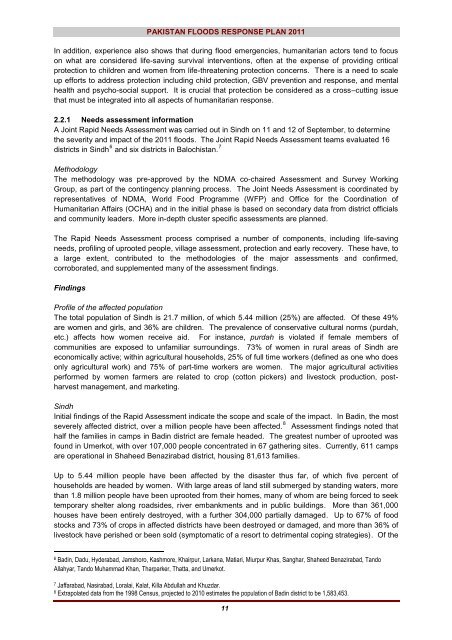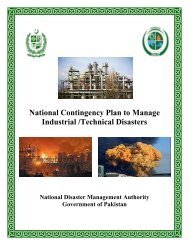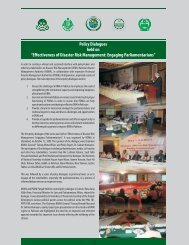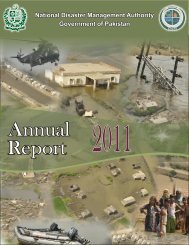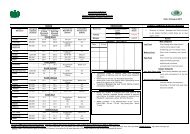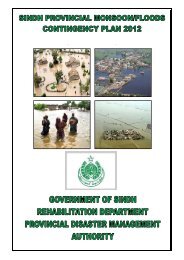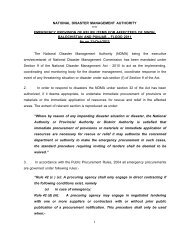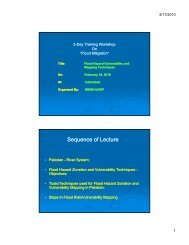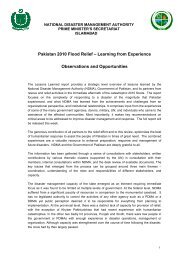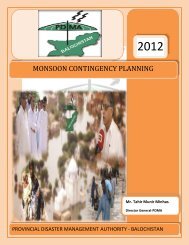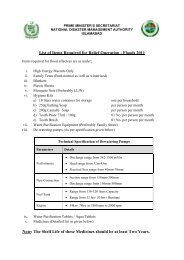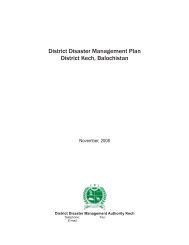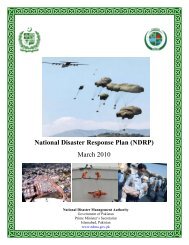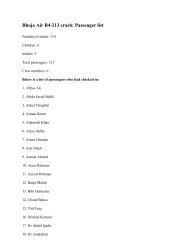Pakistan Floods 2011 - Humanitarian Response
Pakistan Floods 2011 - Humanitarian Response
Pakistan Floods 2011 - Humanitarian Response
- No tags were found...
Create successful ePaper yourself
Turn your PDF publications into a flip-book with our unique Google optimized e-Paper software.
F andF AssessmentPAKISTAN FLOODS RESPONSE PLAN <strong>2011</strong>In addition, experience also shows that during flood emergencies, humanitarian actors tend to focuson what are considered life-saving survival interventions, often at the expense of providing criticalprotection to children and women from life-threatening protection concerns. There is a need to scaleup efforts to address protection including child protection, GBV prevention and response, and mentalhealth and psycho-social support. It is crucial that protection be considered as a cross–cutting issuethat must be integrated into all aspects of humanitarian response.2.2.1 Needs assessment informationA Joint Rapid Needs Assessment was carried out in Sindh on 11 and 12 of September, to determinethe severity and impact of the <strong>2011</strong> floods. The Joint Rapid Needs Assessment teams evaluated 1667districts in SindhF six districts in Balochistan.FMethodologyThe methodology was pre-approved by the NDMA co-chaired Assessment and Survey WorkingGroup, as part of the contingency planning process. The Joint Needs Assessment is coordinated byrepresentatives of NDMA, World Food Programme (WFP) and Office for the Coordination of<strong>Humanitarian</strong> Affairs (OCHA) and in the initial phase is based on secondary data from district officialsand community leaders. More in-depth cluster specific assessments are planned.The Rapid Needs Assessment process comprised a number of components, including life-savingneeds, profiling of uprooted people, village assessment, protection and early recovery. These have, toa large extent, contributed to the methodologies of the major assessments and confirmed,corroborated, and supplemented many of the assessment findings.FindingsProfile of the affected populationThe total population of Sindh is 21.7 million, of which 5.44 million (25%) are affected. Of these 49%are women and girls, and 36% are children. The prevalence of conservative cultural norms (purdah,etc.) affects how women receive aid. For instance, purdah is violated if female members ofcommunities are exposed to unfamiliar surroundings. 73% of women in rural areas of Sindh areeconomically active; within agricultural households, 25% of full time workers (defined as one who doesonly agricultural work) and 75% of part-time workers are women. The major agricultural activitiesperformed by women farmers are related to crop (cotton pickers) and livestock production, postharvestmanagement, and marketing.SindhInitial findings of the Rapid Assessment indicate the scope and scale of the impact. In Badin, the most8severely affected district, over a million people have been affected. Ffindings noted thathalf the families in camps in Badin district are female headed. The greatest number of uprooted wasfound in Umerkot, with over 107,000 people concentrated in 67 gathering sites. Currently, 611 campsare operational in Shaheed Benazirabad district, housing 81,613 families.Up to 5.44 million people have been affected by the disaster thus far, of which five percent ofhouseholds are headed by women. With large areas of land still submerged by standing waters, morethan 1.8 million people have been uprooted from their homes, many of whom are being forced to seektemporary shelter along roadsides, river embankments and in public buildings. More than 361,000houses have been entirely destroyed, with a further 304,000 partially damaged. Up to 67% of foodstocks and 73% of crops in affected districts have been destroyed or damaged, and more than 36% oflivestock have perished or been sold (symptomatic of a resort to detrimental coping strategies). Of the6Badin, Dadu, Hyderabad, Jamshoro, Kashmore, Khairpur, Larkana, Matiari, Miurpur Khas, Sanghar, Shaheed Benazirabad, TandoAllahyar, Tando Muhammad Khan, Tharparker, Thatta, and Umerkot.7Jaffarabad, Nasirabad, Loralai, Kalat, Killa Abdullah and Khuzdar.8Extrapolated data from the 1998 Census, projected to 2010 estimates the population of Badin district to be 1,583,453.11


